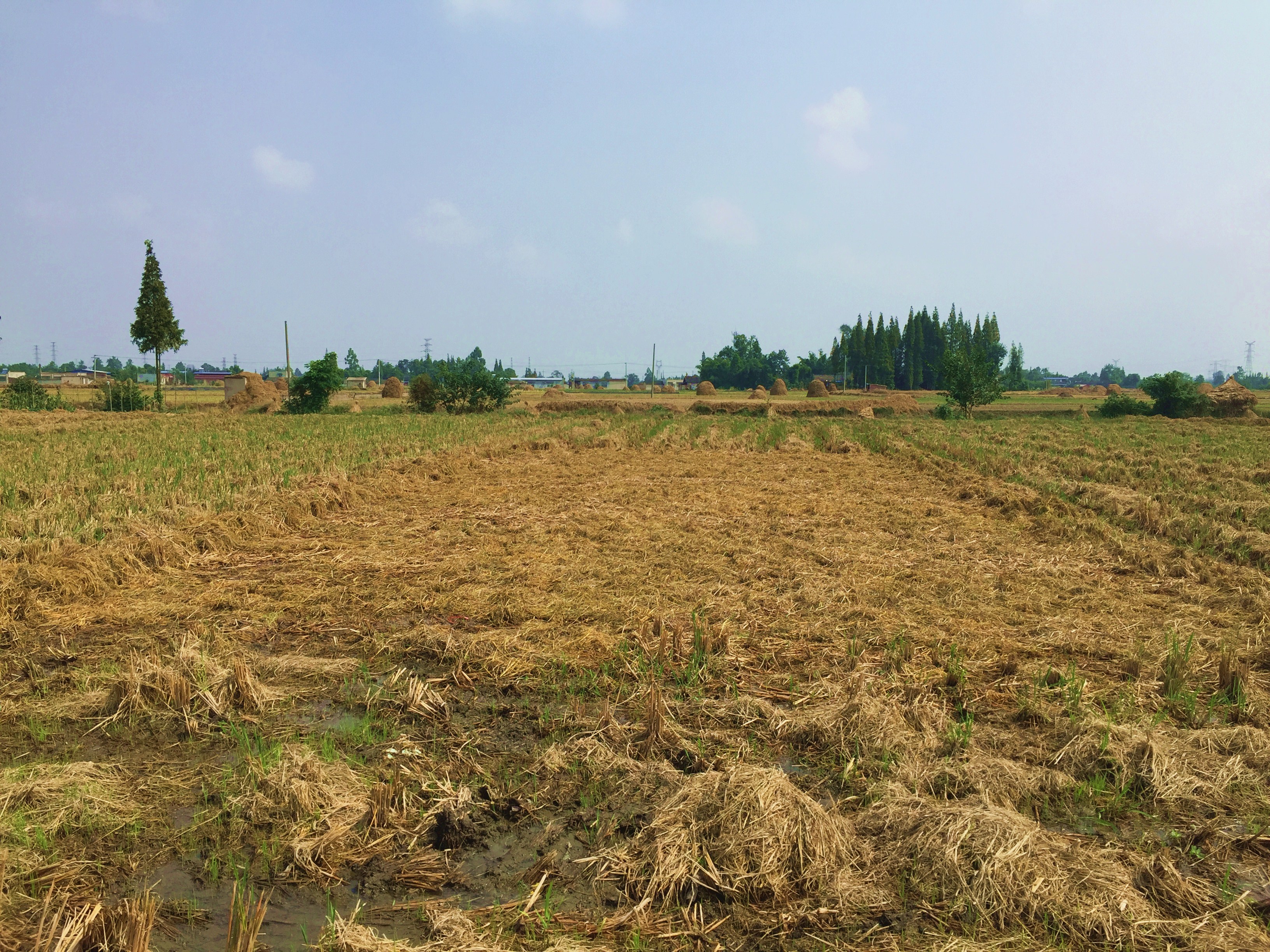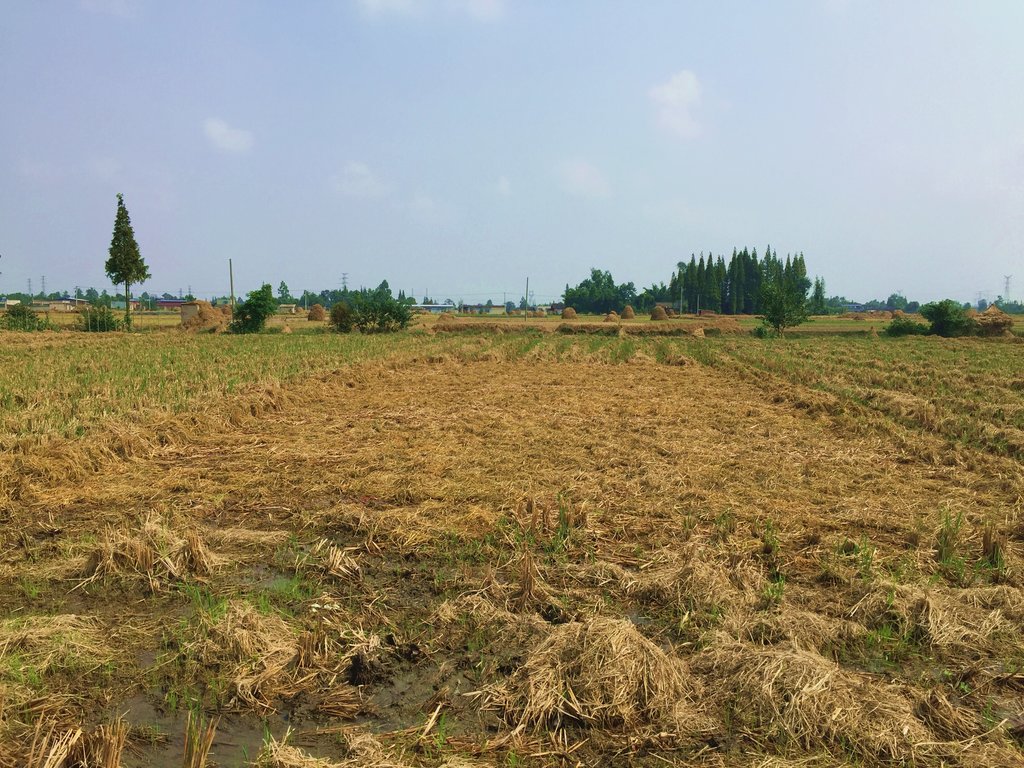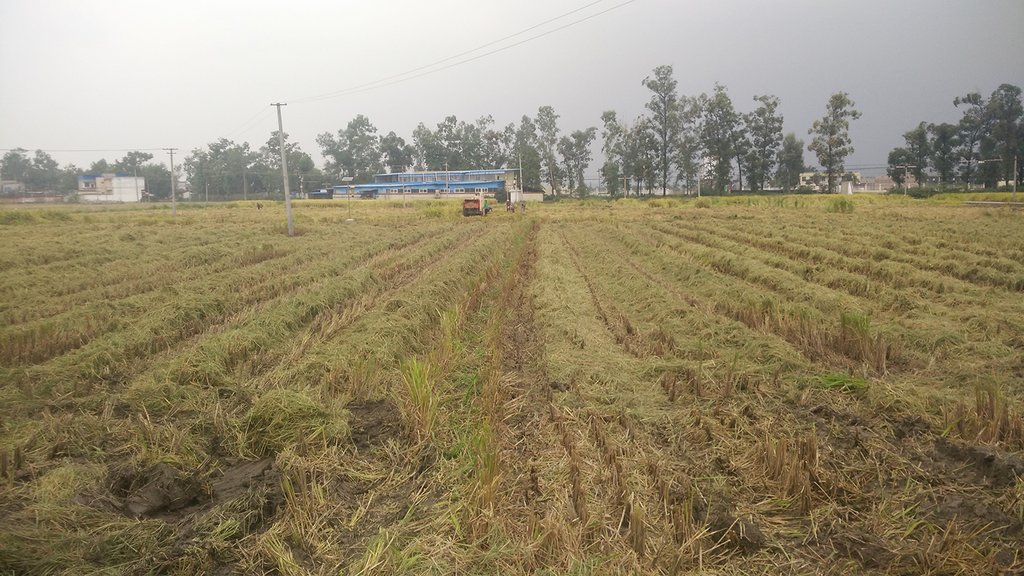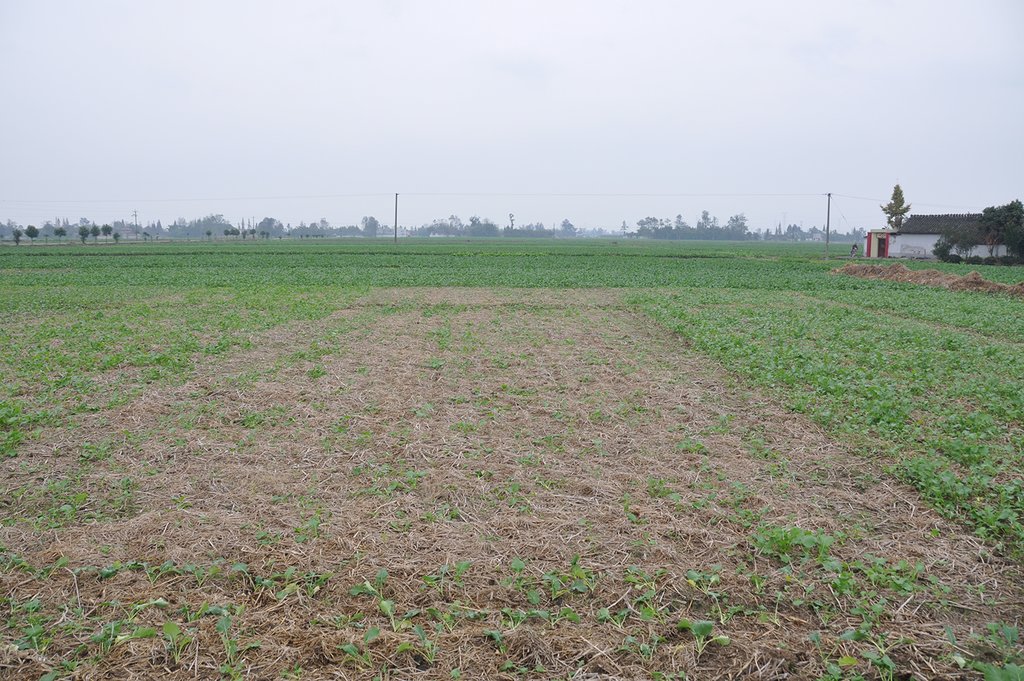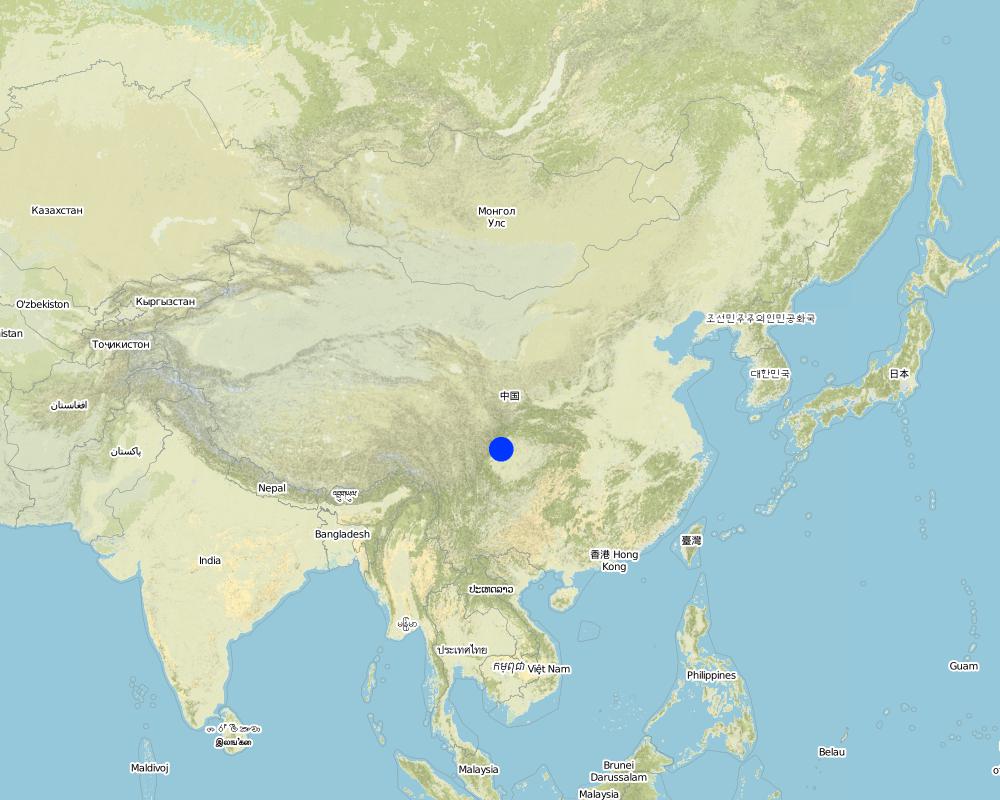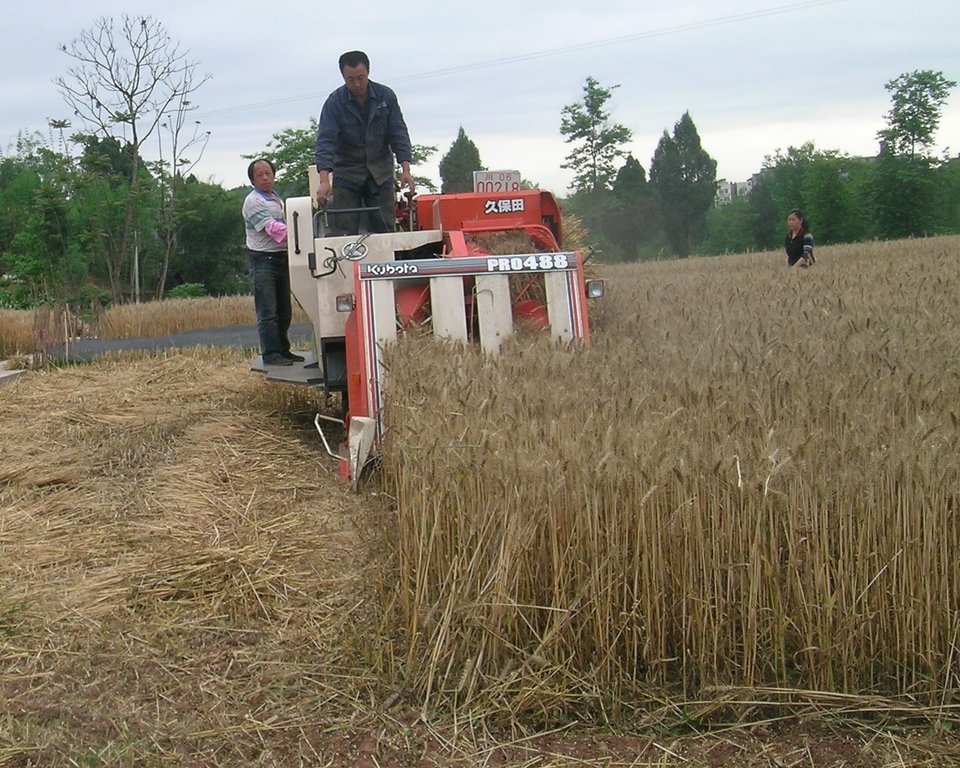Straw residues left on field after harvest and no tillage [China]
- Criação:
- Atualização:
- Compilador/a: Song Guo
- Editor: –
- Revisores: Gudrun Schwilch, Ursula Gaemperli, Alexandra Gavilano
No tillage planting
technologies_3239 - China
Veja as seções
Expandir tudo Recolher tudo1. Informação geral
1.2 Detalhes do contato das pessoas capacitadas e instituições envolvidas na avaliação e documentação da tecnologia
Pessoa(s) capacitada(s)
Especialista em GST:
Hongzhu Fan
Soil and Fertilizer Institute of the Sichuan Academy of Agricultural Sciences
China
usuário de terra:
Wu Shengde
China
Nome do projeto que facilitou a documentação/avaliação da Tecnologia (se relevante)
Interactive Soil Quality assessment in Europe and China for Agricultural productivity and Environmental Resilience (EU-iSQAPER)Nome da(s) instituição(ões) que facilitou(ram) a documentação/ avaliação da Tecnologia (se relevante)
‒ Soil and Fertilizer Institute of the Sichuan Academy of Agricultural Sciences (SFI) - China1.3 Condições em relação ao uso da informação documentada através de WOCAT
O compilador e a(s) pessoa(s) capacitada(s) aceitam as condições relativas ao uso de dados documentados através do WOCAT:
Sim
1.4 Declaração de sustentabilidade da tecnologia descrita
A tecnologia descrita aqui é problemática em relação a degradação da terra de forma que não pode ser declarada uma tecnologia de gestão sustentável de terra?
Não
2. Descrição da tecnologia de GST
2.1 Descrição curta da tecnologia
Definição da tecnologia:
Method of this agricultual technology the rice straw will be left on the field after mechanized harvesting. Succession crop, such as rape, wheat or potato, were seeded directly under no tillage condition. Both measures aim at better soil regeneration and soil conditions for agriculture and subsequently increased yield and less soil degradation.
2.2 Descrição detalhada da tecnologia
Descrição:
The SLM practice (straw mulching and no tillage) is applied in the Chengdu Plain Paddy Soil. The Chengdu plain has mild climate and abundant rainfall. It belongs to the warm humid subtropical Pacific monsoon climate zone.The main types of soil in the Chengdu plain are paddy soil and purple soil.The total land resources of the Chengdu plain are 1331800 hectares, and the per capita land resources are about 0.1044 hectares per person. In 2010, the total amount of cultivated land in the Chengdu plain was 478069 hectares, accounting for 35.90% of the area of the plain, accounting for 42.36% of the total area of agricultural land in the region, and the per capita arable land area was only about 0.0375 hectares. The Chengdu Plain is an important grain production base in Sichuan. Rice field-upland field rotation (rice - wheat, rice - rapeseed) is an important agricultural system.
On the case study area, the N, P and K fertilizers were applied as urea, calcium superphosphate and potassium chloride at the rates of 120-150 kg N ha-1, 75-120 kg P2O5 ha-1,and 75-120 kg K2O ha-1, during every crop. During crop season, the rate of 60% of N, 100% of P, and 50% of K fertilizers were applied as base fertilizer, while remaining 40% of N and 50% of K were used as top dressing fertilizer. The main measures of this SLM is rice straw or wheat straw mulching while havesting (leaving the straw after havest scattered on the field). Crops were harvested by a combine harvester (Kuotian combine harvester, model PR0488), then straw and stubble of crops were left at size of less than 20 cm in the field. The seeding of succession crop such as wheat and oil seed rape is done by a direct seeding machine. The land users are working eighter with a contractor or they use their own machines and labour force. The purposes of this technology were to increase production and improve soil fertility. Although plough layer can become shallow by long-term no tillage cultivation, more and more land users like this technology because it promises increased grain yield, reduction of fertilizers (and subsequently cost), and it improves soil physical, chemical and biological properties of soil. Thus, it is expected that the measures of this SLM-Technology ends up in improved soil moisture, higher diversity of soil life and finally soil fertility .
2.3 Fotos da tecnologia
2.5 País/região/locais onde a tecnologia foi aplicada e que estão cobertos nesta avaliação
País:
China
Região/Estado/Província:
Basin plain, Chengdu, Sichuan
Especificação adicional de localização:
Guanhan City, Wenjiang District, Chongzhou City
Especifique a difusão da tecnologia:
- Uniformemente difundida numa área
Se a área precisa não for conhecida, indicar a área aproximada coberta:
- 100-1.000 km2
Comentários:
This long-term straw mulch experiment was started in the 2005. This site is situated in subtropical monsoon region with anverage annual temperature of about 16.3℃, 281 days frost free. Annual precipitation is about 890mm.
Map
×2.6 Data da implementação
Caso o ano exato seja desconhecido, indique a data aproximada:
- 10-50 anos atrás
2.7 Introdução da tecnologia
Especifique como a tecnologia foi introduzida:
- durante experiências/ pesquisa
Comentários (tipos de projeto, etc.):
The current case study bases only on a test area within the scope of the iSQAPER Project. A long-term straw mulch and fertilization experiment was initiated in 2005 at Sichuan Academy of Agricultural Sciences Soil and Fertilizer Research Institute’s Guanghan agricultural experiment station in Sichuan province, southwest China. Thus, effects of long-term fertilization and straw much on crop yields, soil physical and chemical properties under rice-rapeseed rotation were assessed in a paddy soil
3. Classificação da tecnologia de GST
3.1 Principal/principais finalidade(s) da tecnologia
- Melhora a produção
- Reduz, previne, recupera a degradação do solo
- Preserva ecossistema
- Preservar/melhorar a biodiversidade
3.2 Tipo(s) atualizado(s) de uso da terra onde a tecnologia foi aplicada

Terra de cultivo
- Cultura anual
Cultivo anual - Especificar culturas:
- culturas oleaginosas - girassol, colza, outros
- wheat, rice
Número de estações de cultivo por ano:
- 2
O rodízio de culturas é praticado?
Sim
Caso afirmativo, especifique:
Method of this agricultual technology the rice straw will be left on the field after mechanized harvesting. Succession crop, such as rape, wheat or potato, were seeded directly under no tillage condition.
3.4 Abastecimento de água
Abastecimento de água para a terra na qual a tecnologia é aplicada:
- Misto de precipitação natural-irrigado
3.5 Grupo de GST ao qual pertence a tecnologia
- sistema rotativo (rotação de culturas, pousios, cultivo itinerante)
- Solo/cobertura vegetal melhorada
- Perturbação mínima ao solo
3.6 Medidas de GST contendo a tecnologia

Medidas agronômicas
- A1: cobertura vegetal/do solo
- A2: Matéria orgânica/fertilidade do solo
- A3: Tratamento da superfície do solo
3.7 Principais tipos de degradação da terra abordados pela tecnologia

Deteriorização química do solo
- Cn: declínio de fertilidade e teor reduzido de matéria orgânica (não causado pela erosão)

Deteriorização física do solo
- Pc: Compactação
- Pk: quebra e ressecamento
3.8 Redução, prevenção ou recuperação da degradação do solo
Especifique o objetivo da tecnologia em relação a degradação da terra:
- Prevenir degradação do solo
4. Especificações técnicas, implementação de atividades, entradas e custos
4.1 Desenho técnico da tecnologia
Especificações técnicas (relacionada ao desenho técnico):
The SLM practice (straw mulching while harvesting and no tillage) is applied in the Chengdu Plain paddy soil. The main measures of this SLM method is straw mulching while harvesting and no tillage. Crops are harvested by machine (actually in this case study by Kuotian combine harvester/model was PR0488), and then straw and stubble were left at size of less than 20 cm on the soil surface. The N, P and K fertilizers to the succession crop were applied in form of urea, calcium superphosphate and potassium chloride at the rates of 120-150 kg N ha-1, 75-120 kg P2O5 ha-1, and 75-120 kg K2O ha-1. Rates of 60% of N, 100% of P and 50% of K fertilizers were applied as base fertilizers, while the remaining 40% of N and 50% of K were used as top dressing fertilizers. After previous crop harvest of rice the succession crop as for example wheat, oil rape, maize will be seeded directly under no tillage condition.
Autor:
Hongzhu Fan
Data:
30/10/2017
4.2 Informação geral em relação ao cálculo de entradas e custos
Especifique como custos e entradas foram calculados:
- por área de tecnologia
Indique o tamanho e a unidade de área:
1 hectare
Outro/moeda nacional (especifique):
Renminbi (RMB)
Se for relevante, indique a taxa de câmbio do USD para moeda local (por exemplo, 1 USD = 79,9 Real): 1 USD =:
6,6
Indique a média salarial da mão-de-obra contratada por dia:
120 RMB per day
4.5 Atividades recorrentes/manutenção
| Atividade | Periodicidade/frequência | |
|---|---|---|
| 1. | mechanized harvesting | August or September |
| 2. | spreading the straw residues after havest on the field | after harvest of crops |
| 3. | fertilization | October |
| 4. | no tillage and direct seeding | October |
4.6 Custos e entradas necessárias pata a manutenção/atividades recorrentes (por ano)
| Especifique a entrada | Unidade | Quantidade | Custos por unidade | Custos totais por entrada | % dos custos arcados pelos usuários da terra | |
|---|---|---|---|---|---|---|
| Mão-de-obra | All reccurent labour (above) is done within the familiy* | person-day | 0,5 | 120,0 | 60,0 | 100,0 |
| Equipamento | harvester (machine from contractor without labour force)* | ha | 1,0 | 3000,0 | 3000,0 | 100,0 |
| Equipamento | Direct seeding machine (from contractor without labour force)* | ha | 1,0 | 1800,0 | 1800,0 | |
| Material vegetal | seed (weat, rape) | kg | 120,0 | 2,0 | 240,0 | 100,0 |
| Fertilizantes e biocidas | urea | kg | 280,0 | 3,0 | 840,0 | 100,0 |
| Fertilizantes e biocidas | calcuim superphosphate | kg | 810,0 | 1,0 | 810,0 | 100,0 |
| Fertilizantes e biocidas | potassium chloride | kg | 200,0 | 3,5 | 700,0 | 100,0 |
| Custos totais para a manutenção da tecnologia | 7450,0 | |||||
| Custos totais de manutenção da Tecnologia em USD | 1128,79 | |||||
Comentários:
*The labour (for harvesting, fertilizering and seeding ) is unpaid when those were done by farm familiy.
But in China, there is no contractor to do all work (for harvesting, fertilizing and seeding). If all works done by a contractor, farms will give up planting crops. Usually, a contractor provide machine to farm, but no labor. Farm members engaged in agricultural production will do most of the work by themselves in order to save cost.
4.7 Fatores mais importantes que afetam os custos
Descreva os fatores mais determinantes que afetam os custos:
Most of important factor affecting the costs of this technology is the type of machine used for harvest. (E.g. cost is high by the mini combine harvester because of the low efficiency).
5. Ambiente natural e humano
5.1 Clima
Precipitação pluviométrica anual
- <250 mm
- 251-500 mm
- 501-750 mm
- 751-1.000 mm
- 1.001-1.500 mm
- 1.501-2.000 mm
- 2.001-3.000 mm
- 3.001-4.000 mm
- > 4.000 mm
Zona agroclimática
- Subúmido
5.2 Topografia
Declividade média:
- Plano (0-2%)
- Suave ondulado (3-5%)
- Ondulado (6-10%)
- Moderadamente ondulado (11-15%)
- Forte ondulado (16-30%)
- Montanhoso (31-60%)
- Escarpado (>60%)
Formas de relevo:
- Planalto/planície
- Cumes
- Encosta de serra
- Encosta de morro
- Sopés
- Fundos de vale
Zona de altitude:
- 0-100 m s.n.m.
- 101-500 m s.n.m.
- 501-1.000 m s.n.m.
- 1.001-1.500 m s.n.m.
- 1.501-2.000 m s.n.m.
- 2.001-2.500 m s.n.m.
- 2.501-3.000 m s.n.m.
- 3.001-4.000 m s.n.m.
- > 4.000 m s.n.m.
Indique se a tecnologia é aplicada especificamente em:
- Não relevante
5.3 Solos
Profundidade do solo em média:
- Muito raso (0-20 cm)
- Raso (21-50 cm)
- Moderadamente profundo (51-80 cm)
- Profundo (81-120 cm)
- Muito profundo (>120 cm)
Textura do solo (solo superficial):
- Médio (limoso, siltoso)
Textura do solo (>20 cm abaixo da superfície):
- Grosso/fino (arenoso)
Matéria orgânica do solo superficial:
- Médio (1-3%)
Caso disponível anexe a descrição completa do solo ou especifique as informações disponíveis, p. ex. tipo de solo, PH/acidez do solo, nitrogênio, capacidade de troca catiônica, salinidade, etc.
Soil type is alluvial soil, PH is 5.5, SOC 31.3g/kg, N 2.02g/kg,P 1.04g/kg, K 7.69g/kg, available nitrogen 189.7mg/kg, available phosphorus 12.6mg/kg, ammonium acetate extractable potassium95.5mg/kg.
5.4 Disponibilidade e qualidade de água
Lençol freático:
< 5 m
Disponibilidade de água de superfície:
Médio
Qualidade da água (não tratada):
Água potável boa
A salinidade da água é um problema?
Não
Ocorre inundação da área?
Não
5.5 Biodiversidade
Diversidade de espécies:
- Alto
Diversidade de habitat:
- Alto
5.6 Características dos usuários da terra que utilizam a tecnologia
Sedentário ou nômade:
- Sedentário
Orientação de mercado do sistema de produção:
- misto (subsistência/comercial)
Rendimento não agrícola:
- Menos de 10% de toda renda
Nível relativo de riqueza:
- Média
Indivíduos ou grupos:
- Grupos/comunidade
Nível de mecanização:
- Mecanizado/motorizado
Gênero:
- Mulheres
Idade dos usuários da terra:
- meia-idade
5.7 Área média de terrenos utilizados pelos usuários de terrenos que aplicam a Tecnologia
- < 0,5 ha
- 0,5-1 ha
- 1-2 ha
- 2-5 ha
- 5-15 ha
- 15-50 ha
- 50-100 ha
- 100-500 ha
- 500-1.000 ha
- 1.000-10.000 ha
- > 10.000 ha
É considerado pequena, média ou grande escala (referente ao contexto local)?
- Média escala
5.8 Propriedade de terra, direitos de uso da terra e de uso da água
Propriedade da terra:
- Estado
Direitos do uso da terra:
- Comunitário (organizado)
Direitos do uso da água:
- Comunitário (organizado)
Comentários:
In China, land ownership belongs to the state, but land use rights belong to farm. In other words, farm can decide to plant rice, wheat, or fruit tree in the land, but the farm cannot sell this land.
5.9 Acesso a serviços e infraestrutura
Saúde:
- Pobre
- Moderado
- Bom
Educação:
- Pobre
- Moderado
- Bom
Assistência técnica:
- Pobre
- Moderado
- Bom
Emprego (p. ex. não agrícola):
- Pobre
- Moderado
- Bom
Mercados:
- Pobre
- Moderado
- Bom
Energia:
- Pobre
- Moderado
- Bom
Vias e transporte:
- Pobre
- Moderado
- Bom
Água potável e saneamento:
- Pobre
- Moderado
- Bom
Serviços financeiros:
- Pobre
- Moderado
- Bom
6. Impactos e declarações finais
6.1 Impactos no local mostrados pela tecnologia
Impactos socioeconômicos
Produção
Produção agrícola
Quantidade anterior à GST:
14.9 t ha-1*
Quantidade posterior à GST:
15.5 t ha-1*
Comentários/especificar:
* yield for rape
Wheat yield were 6.3 t ha-1 before SLM and 6.7 t ha-1 after SLM, respectively. Rice yield were 8.6 t ha-1 before SLM and 8.8 t ha-1 after SLM, respectively.
Gestão de terra
Comentários/especificar:
No tillage is an important way to reduce cost by machine plough field. Less fertilizing work and amount of fertilizers by leaving straw on field (straw contains a large amount of C, N, P, and K)
Disponibilidade e qualidade de água
Demanda por água para irrigação
Comentários/especificar:
Straw mulching can decreased demand for irrigation water, because water can be keep in the straw, and straw mulching on the soil also can reduced evaporation of water.
Renda e custos
Despesas com insumos agrícolas
Comentários/especificar:
No tillage is an important way to reduce cost by machine plough field. Less fertilizing work and amount of fertilizers by straw return compared with no straw mulching (straw contains a large number of C, N, P and K. Therefore agricultural inputs can be reduced.
Rendimento agrícola
Comentários/especificar:
Do to better yield and reduction of costs.
Carga de trabalho
Impactos socioculturais
Conhecimento de GST/ degradação da terra
Comentários/especificar:
Increased knowledge on the benefits of straw mulching by the land users.
Impactos ecológicos
Solo
Umidade do solo
Comentários/especificar:
Due to straw mulching, because the water can be kept in the straw and soil evaporation can be reduced to improved oil cover.
Cobertura do solo
Comentários/especificar:
Due to the mulching by straw, the soil remain covered practically the whole year round.
Ressecamento/ selagem do solo
Comentários/especificar:
Without ploughing the soil crusting can occur at long term use of the technology (findings from a long-term straw mulch and fertilization experiment was initiated in 2005 at Sichuan Academy of Agricultural Sciences Soil and Fertilizer Research Institute’s Guanghan agricultural experiment station in Sichuan province)
Compactação do solo
Comentários/especificar:
Without ploughing the soil gets more compact at long term use of the technology (findings from a long-term straw mulch and fertilization experiment was initiated in 2005 at Sichuan Academy of Agricultural Sciences Soil and Fertilizer Research Institute’s Guanghan agricultural experiment station in Sichuan province)
Ciclo e recarga de nutrientes
Matéria orgânica do solo/carbono abaixo do solo
Comentários/especificar:
Due to mulching by rice straw (crop residues)
Biodiversidade: vegetação, animais
Biomassa/carbono acima do solo
Comentários/especificar:
Due to mulching by rice straw (crop residues)
Diversidade animal
Comentários/especificar:
Due to mulching by rice straw (crop residues), soil life has increased.
Espécies benéficas
Clima e redução de riscos de desastre
Emissão de carbono e gases de efeito estufa
Comentários/especificar:
Traditional burning of rice straw on the fields has been reduced, as straw is needed for mulching. Subsequently the C can be bound within the soil and will not be emitted into the air in form of CO2.
6.2 Impactos externos mostrados pela tecnologia
Impacto dos gases de efeito estufa
Comentários/especificar:
Traditional burning of rice straw on the fields has been reduced, as straw is needed for mulching. Subsequently the C can be bound within the soil and will not be emitted into the air in form of CO2.
6.4 Análise do custo-benefício
Como os benefícios se comparam aos custos recorrentes/de manutenção(do ponto de vista dos usuários da terra)?
Retornos a curto prazo:
levemente positivo
Retornos a longo prazo:
positivo
6.5 Adoção da tecnologia
- 11-50%
De todos aqueles que adotaram a Tecnologia, quantos o fizeram espontaneamente, ou seja, sem receber nenhum incentivo/ pagamento material?
- 91-100%
6.6 Adaptação
A tecnologia foi recentemente modificada para adaptar-se as condições variáveis?
Não
6.7 Pontos fortes/vantagens/oportunidades da tecnologia
| Pontos fortes/vantagens/oportunidades na visão do usuário da terra |
|---|
| This technology can improve the yield |
| It can save labour by leaving straw on the field |
| Pontos fortes/vantagens/oportunidades na visão do compilador ou de outra pessoa capacitada |
|---|
| Straw mulching can increase the soil carbon input, and improve the soil quantity. |
| This technology can reduce land degradation. |
6.8 Pontos fracos, desvantagens/riscos da tecnologia e formas de superá-los
| Pontos fracos/desvantagens/riscos na visão do usuário da terra | Como eles podem ser superados? |
|---|---|
| Soil structure was deteriorated by no tillage cultivation. | tillage |
| Pontos fracos/vantagens/riscos na visão do compilador ou de outra pessoa capacitada | Como eles podem ser superados? |
|---|---|
| Soil hardening occured, and also a thin impervious layer was built at the soil surface | It could be good to plough up the soil after an interval of 5 years |
| Obstruction of rainwater infiltration | |
| Soil plough layer becomes shallow |
7. Referências e links
7.1 Métodos/fontes de informação
- entrevistas com usuários de terras
94 people
- compilação de relatórios e outra documentação existente
Quando os dados foram compilados (no campo)?
20/09/2016
7.2 Referências às publicações disponíveis
Título, autor, ano, ISBN:
Composition of Wheat Rhizosphere Antagonistic Bacteria and Wheat Sharp Eyespot as Affected by Rice Straw Mulching. CHEN Huai-Gu, CAO Qi-Guang, XIONG Gui-Lin, LI Wei, ZHANG Ai-Xiang, YU Han-Shou and WANG Jin-Sheng.2010.
Disponível de onde? Custos?
ScienceDirect. No
Título, autor, ano, ISBN:
Effects of pre-sowing irrigation and straw mulching on the grain yieldand water use efficiency of summer maize in the North China Plain. Zhenxing Yan, Chao Gao, Yujie Ren, Rui Zong, Yuzhao Ma, Quanqi Li. 2017
Disponível de onde? Custos?
ScienceDirect. No
Título, autor, ano, ISBN:
Effects of snow cover plus straw mulching on microorganisms in paddy soil during winter.Hao Zhanga,b, Jie Tanga, Shuang Liang.2017
Disponível de onde? Custos?
ScienceDirect. No
Título, autor, ano, ISBN:
Effects of Non-flooded Cultivation with Straw Mulching on Rice Agronomic Traits and Water Use Efficiency. QIN Jiang-tao , HU Feng , LI Hui-xin , WANG Yi-ping , HUANG Fa-quan , HUANG Hua-xiang.2006
Disponível de onde? Custos?
ScienceDirect. No
Título, autor, ano, ISBN:
Growth Characteristics and Yield of Late-Season Rice under No-tillageand Non-flooded Cultivation with Straw Mulching. WANG Dong, LI Hui-xin, QIN Jiang-tao, LI Da-ming, HU Feng.2010
Disponível de onde? Custos?
ScienceDirect. No
Título, autor, ano, ISBN:
Impact of tillage practices on soil bacterial diversity and composition under the tobacco-rice rotation in China. Yanping Lei, Yongliang Xiao, Lifeng Li,Chaoqiang Jiang, Chaolong Zu, Tian Li, and Hui Cao.2017
Disponível de onde? Custos?
ScienceDirect. No
Título, autor, ano, ISBN:
Nutrient Decomposition Rate and Sugarcane Yield as Influenced by Mung Bean Intercropping and Crop Residue Recycling Tie-Guang He,Li-Rong Su,Yang-Rui Li,Tian-Ming Su2 Fang Qin,Qin Li.2017
Disponível de onde? Custos?
ScienceDirect. No
Título, autor, ano, ISBN:
Process rates of nitrogen cycle in uppermost topsoil after harvesting in no-tilled and ploughed agricultural clay soil. Merjo Laine . Tobias Ru¨ tting . Laura Alakukku . Ansa Paloja¨rvi . Rauni Stro¨mmer.2017
Disponível de onde? Custos?
ScienceDirect. No
Título, autor, ano, ISBN:
Research on the effect of straw mulching on the soil moisture by field experiment in the piedmont plain of the Taihang Mountains. LI Man, ZHANG Wei, HE Yu-jiang, WANG Gui-ling.2017
Disponível de onde? Custos?
ScienceDirect. No
Título, autor, ano, ISBN:
Rice–wheat cropping system: tillage, mulch, and nitrogen effects on soil carbon sequestration and crop productivity Keshav R. Adhikari,Khem R. Dahal,Zueng-Sang Chen,Yih-Chi Tan,Jihn-Sung Lai.2017
Disponível de onde? Custos?
ScienceDirect. No
Título, autor, ano, ISBN:
Soil Carbon Sequestration and Crop Yields in Rice–Wheat and Sugarcane–Ratoon–Wheat Cropping Systems Through Crop Residue Management and Inoculation of Trichoderma viride in Subtropical India.S. K. Shukla,Swaha Shee,S. K. Maity,S. Solomon,S. K. Awasthi,Asha Gaur,A. D. Pathak,V. P. Jaiswal.2017
Disponível de onde? Custos?
ScienceDirect. No
Título, autor, ano, ISBN:
成都平原麦稻双免耕秸秆还田技术模式.汤永禄 , 黄钢, 郑家国, 李朝苏,邓先和,付书明.2008
Disponível de onde? Custos?
http://www.cnki.net/. No
Título, autor, ano, ISBN:
Influence of straw mulching with no-till on soil nutrients and carbon pool management index.CHEN Shang-hong, ZHU Zhong-lin, LIU Ding-hui, SHU Li , WANG Chang-quan.2008
Disponível de onde? Custos?
http://www.cnki.net/. No
7.3 Links para informações on-line relevantes
Título/ descrição:
Effects of pre-sowing irrigation and straw mulching on the grain yieldand water use efficiency of summer maize in the North China Plain.
URL:
http://dx.doi.org/10.1016/j.agwat.2017.02.017
Título/ descrição:
Effects of snow cover plus straw mulching on microorganisms in paddy soil during winter
URL:
http://dx.doi.org/10.1016/j.apsoil.2017.05.023
Título/ descrição:
Growth Characteristics and Yield of Late-Season Rice under No-tillageand Non-flooded Cultivation with Straw Mulching
URL:
DOI: 10.1016/S1672-6308(08)60117-1
Título/ descrição:
Impact of tillage practices on soil bacterial diversity and composition under the tobacco-rice rotation in China
URL:
DOI 10.1007/s12275-017-6242-9
Título/ descrição:
Nutrient Decomposition Rate and Sugarcane Yield as Influenced by Mung Bean Intercropping and Crop Residue Recycling
URL:
DOI 10.1007/s12355-017-0548-0
Título/ descrição:
Process rates of nitrogen cycle in uppermost topsoil after harvesting in no-tilled and ploughed agricultural clay soil
URL:
DOI 10.1007/s10705-017-9825-2
Título/ descrição:
Rice–wheat cropping system: tillage, mulch, and nitrogen effects on soil carbon sequestration and crop productivity
URL:
DOI 10.1007/s10333-015-0511-1
Título/ descrição:
Soil Carbon Sequestration and Crop Yields in Rice–Wheat and Sugarcane–Ratoon–Wheat Cropping Systems Through Crop Residue Management and Inoculation of Trichoderma viride in Subtropical
URL:
DOI 10.1007/s12355-016-0470-x
Links e módulos
Expandir tudo Recolher tudoLinks
Não há links
Módulos
Não há módulos


